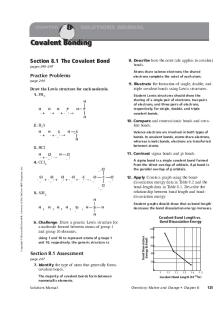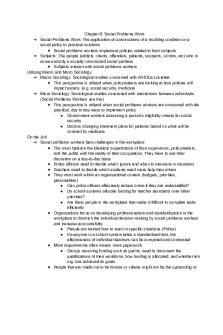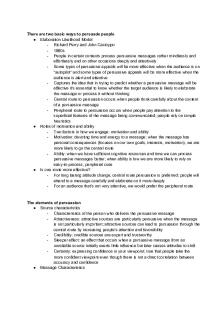Zevin (Chapter 8 Assessment in Social Studies) PDF

| Title | Zevin (Chapter 8 Assessment in Social Studies) |
|---|---|
| Author | Matthew McKenna |
| Course | Theory & Pract In Sec Teaching |
| Institution | Saint Joseph's University |
| Pages | 4 |
| File Size | 98.8 KB |
| File Type | |
| Total Downloads | 31 |
| Total Views | 127 |
Summary
Jack Zevin's Social Studies in the Twenty-First Century Chapter Summaries...
Description
Zevin (Chapter 8: Assessment in Social Studies) Wednesday, February 13, 2019
1.
2.
3.
4. 5.
6.
10:05 AM
The more techniques a teacher uses in assessment, the greater the range of capabilities that will emerge and the more reliable the results (164) Quantity alone is unlikely to be sufficient in determining success because memory/recall represents the lowest level of Bloom’s taxonomy of objectives (164) Measurement is a numerical representation of how much or how well a student has absorbed a specified level of knowledge, skills, or attitudes (166) Polling is a way of estimating the strength or weakness of someone’s perceptions, values and feelings Evaluations gives you a “broad picture of achievement that will serve as a benchmark for individual students, or a whole class” (166) 1. Decide on goals 2. Find out what students know and believe 3. Design curriculum and methods to match your own goals 4. Prepare a summative test and course survey (166) i. Test performance should always be compared with classroom performance for a comprehensive picture of students (167) Portfolio assessment gibes teachers the opportunity to assess development (168) 1. Can include anything that teachers or students will believe are real evidence of progress (168)
Rubrics 1. The best and most useful rubrics are detailed and specific to the curriculum goals (169)
2.
Norm-referenced is relating an individual’s performance to that of a specific group (170) 1. Can be an objective, a criterion, or rubric 2. Against a baseline for the student (170) i. “Student’s evolution” 3. Formative evaluations are tests to acquire feedback from students about ongoing work and attitude development (171) 4. A great variety of testing leads to broader and more comprehensive pictures of individuals and groups in the class (172) Reliability means that measurement instruments yield similar results each time they are given Test validity involves the match among educational objectives, treatment, and test instruments (173) - “this is the quintessential validity problem: the goals and the content of the test do not match; therefore, the test results lead to incorrect conclusions” (173) Informal assessment is the ongoing process of finding out what students know and how they feel (173) - Frequent questioning matched by a high response level improves achievement (173) - Group norms may hide serious problems within groups or among individuals in the class (173) - Measures of satisfaction or agreement can be used to ascertain student interest in a topic or identification with a position or feeling (175) - Decision to establish grades depends on the type of class you have. And your goals (176) - Formative and summative grades should reflect a wide mix of measures ○ Grades should “reward insight, cooperation and care, not quantity” (176) ○ When warranted in grading, be a “bit generous” Information-based questions - Unable to diagnose or assess higher levels of student understanding or affect - I.e. matching, true-false, fill-in, multiple choice (177)
Short answer tests - Easy to invent and grade but students either know or do not know - There are no “discussable answers” (177) Matching - Easy to prepare but does not give a great deal of insight into student reasoning - Greater disparities raise the difficulty levels (178) True-false - Memory, close reading, and definition can play important roles (179) Multiple choice - Good distractors- one obviously wrong, a second almost as good as the correct answer and a third somewhere in between (180) Document-based questions - standard to a good answer is reason (higher-order thinking) - Most important aspect of these questions is that it gives a chance to students to interpret the meaning (180) Teacher questions and oral diagnostics - Ask students probing questions to promote frequent responses (181) Essay tests “By far the best tools to assess student thinking” (186) - There are problems 1. Variability of response 2. Meaning and message 3. The assignment - Essays can be highly creative and difficult, making students develop logical arguments and speculate creatively about the future (186) - Difference between teachers that seek mastery of good writing and mastery of content knowledge (187) - By looking at essays as part and while, you can identify patterns of excellence or misunderstanding among students and compare these
to public criteria or class norms (189) Perception-based questions - Assess how students see the world (stand in someone else’s shoes) - An emotional or empathetic mode of reasoning is required (190) - Psychological instruments measure self-perception and feelings about social roles - Attitudinal measures involve school, society, politics and social issues - Self-evaluative measures involve judgement about quality or educational experience in lessons, units, courses and workshops (190) Measuring student feelings and viewpoints: - Any expression if feeling or judgement is based on experience, knowledge, and reflection, as well as preference and perception (190) - Studying students’ feelings and attitudes should be part of a normal routine - Our perceptions of others cloud our judgement so surveys can help if they are reliable and used diagnostically and professionally (191) - Student interest inventories, checklists, and teacher and course evaluations (192)...
Similar Free PDFs

Chapter 8 assessment
- 19 Pages

Social psychology chapter 8
- 6 Pages

Social Studies - Let Reviewer
- 21 Pages

Diego Social Studies
- 4 Pages

Cultural studies social theory
- 23 Pages

Chapter 8 Social Problems Work
- 3 Pages

Past Papers for Social Studies
- 25 Pages

2018 WI Social Studies Standards
- 42 Pages
Popular Institutions
- Tinajero National High School - Annex
- Politeknik Caltex Riau
- Yokohama City University
- SGT University
- University of Al-Qadisiyah
- Divine Word College of Vigan
- Techniek College Rotterdam
- Universidade de Santiago
- Universiti Teknologi MARA Cawangan Johor Kampus Pasir Gudang
- Poltekkes Kemenkes Yogyakarta
- Baguio City National High School
- Colegio san marcos
- preparatoria uno
- Centro de Bachillerato Tecnológico Industrial y de Servicios No. 107
- Dalian Maritime University
- Quang Trung Secondary School
- Colegio Tecnológico en Informática
- Corporación Regional de Educación Superior
- Grupo CEDVA
- Dar Al Uloom University
- Centro de Estudios Preuniversitarios de la Universidad Nacional de Ingeniería
- 上智大学
- Aakash International School, Nuna Majara
- San Felipe Neri Catholic School
- Kang Chiao International School - New Taipei City
- Misamis Occidental National High School
- Institución Educativa Escuela Normal Juan Ladrilleros
- Kolehiyo ng Pantukan
- Batanes State College
- Instituto Continental
- Sekolah Menengah Kejuruan Kesehatan Kaltara (Tarakan)
- Colegio de La Inmaculada Concepcion - Cebu







